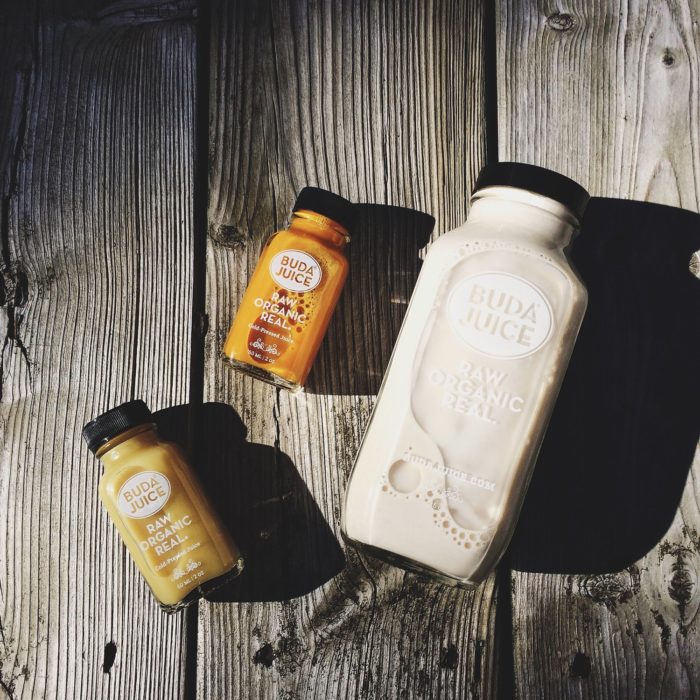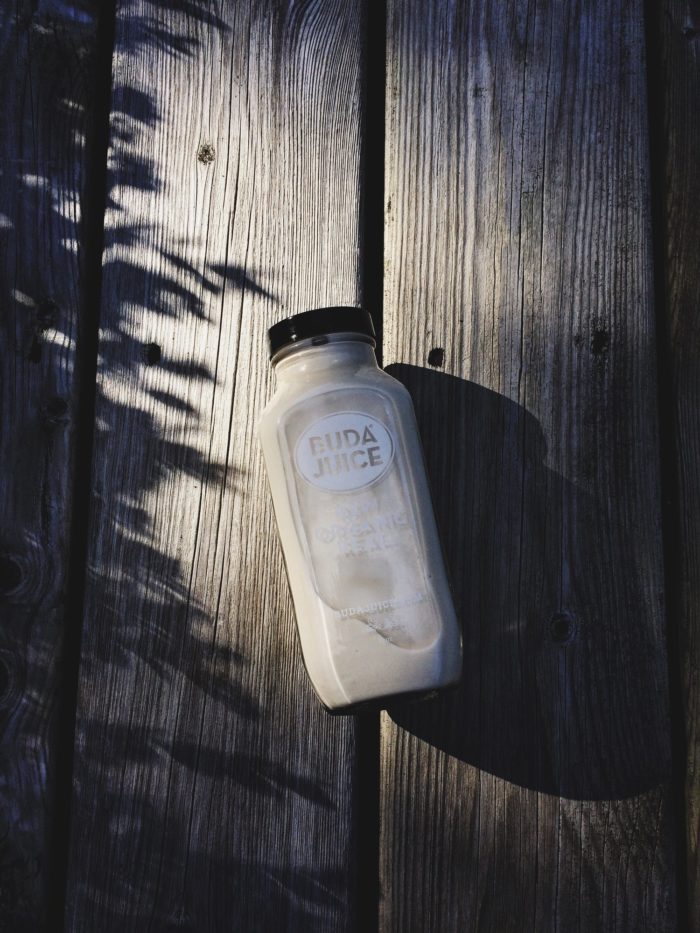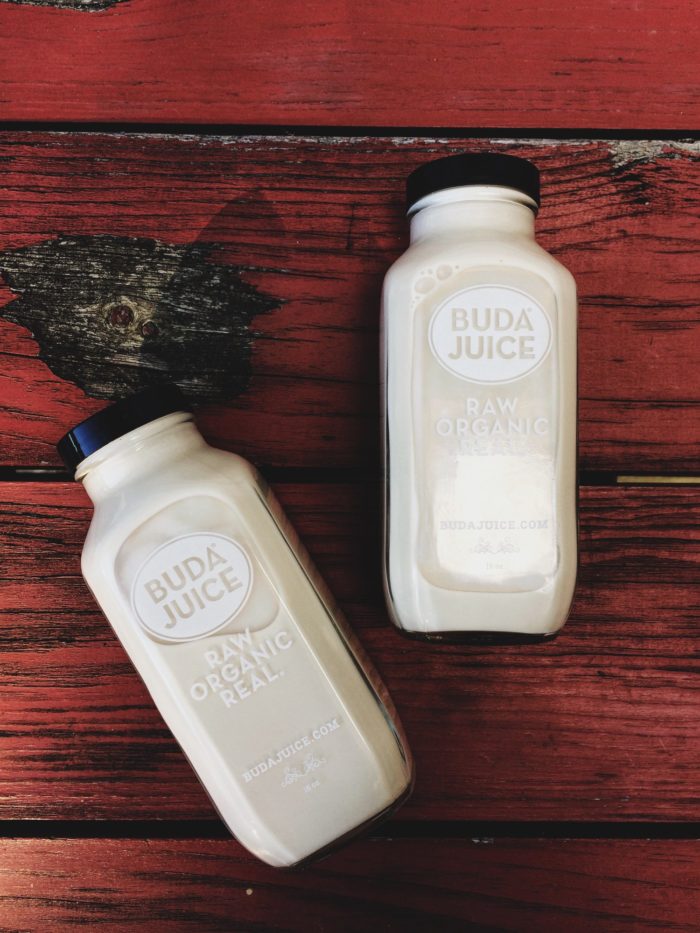Almond milk is one of those uniquely common alternatives to not-so-awesome cow’s milk that’s somehow become coveted of coveted item of both vegans and non-vegans alike. Not often do you find a vegan food item beloved by all that not only boasts a plethora of health benefits but is, in actuality, pretty damn delicious. Somehow, almond milk’s achieved that–and more.
A version of this post previously appeared on JacalynBeales.com.
Growing up, there were no cartons or jars of almond milk littering my grocery store’s shelves. Our mothers didn’t buy $7 jars of vanilla chai milk alternatives or give us glasses filled with hemp milk to accompany our Oreos. We had bagged cow’s milk, something both my brother and I grew up on but which we now both choose to avoid as much as possible–myself more than him. I’m a little more committed to avoiding dairy products like milk after having watched a documentary or two that outlined clearly for me the horrors of the dairy and, more specifically, milk industry(ies). But it wasn’t until the past five years or so that I began seeing cow’s milk alternatives crop up in my local markets and grocery stores. Suddenly, new brands such as Silk and Almond Dream were readily available to consumers, allowing those of us wanting to avoid cow’s milk a so-called “healthy” alternative in the form of almond, soy, hemp, rice, coconut, and other plant-based milk beverages. I hopped aboard that almond milk train and never looked back. Until about a year ago.

Most fresh/cold-pressed juice brands make almond milk, in addition to other little boosters and juices, as seen here.
See, while the milk alternatives we can so easily pick up from our local superstore make it easier on us non-dairy drinkers to enjoy “milk” in all it’s plant-y glory, you might be surprised to discover that most of the almond milk you find produced in mass quantities for grocery store chains are actually filled with synthetic vitamins and weird, sometimes unpronounceable ingredients added to help preserve the beverage for weeks on end until you come along and snatch it up for smoothies, ice creams, and other vegan recipes.
Back in August 2015, I wrote a piece for Selva Beat Magazine which discussed the secret ingredients hidden in almond and other vegan kinds of milk–things like palm oil derivatives and fake vitamins. During the process of pasteurization, for instance, many milk alternatives like almond milk lose a lot of their essential proteins, fatty acids, and vitamins, which means by the time they arrive at your grocery store and head home with you, there’s little to no value in the milk. This also leads these brands to add synthetic vitamins to their “milks” so that you as the consumer get at least some benefit from drinking the product–even if it’s fake. The problem with synthetic vitamins is that the body doesn’t recognize them in the same way it does vitamins from whole foods sources, rendering the synthetic vitamins possibly less useful. Morover, fat-soluble vitamins (like vitamin A) have the potential for vitamin toxicity because they can accumulate in the body’s fat reserves.
Some brands don’t even utilize a number of almonds you’d need in a carton in order to benefit from the natural health properties of almonds. Because many brands use so few almonds per carton, they turn to thickeners like guar gum or locust bean gum. Although these may not be harmful per se, they may cause irritation for those with sensitive digestive systems.
In addition to added synthetic vitamins and thickeners, you’ll also want to look out for carrageenan, a stabilizer and thickening agent derived from seaweed. Carrageenan has yet to be rigorously studied, meaning we don’t know enough about it to trust its safety. Some research has linked the stabilizer to unfortunate intestinal complications.
So, store bought almond milk may not be as wonderful as we once thought, but what’s the alternative and how do we get it?

When it comes to consuming almond milk, everyone has their own preferences; however, I recommend getting your almond milk fix in one (or both) of two ways: make it or buy it. And by “buy it,” I don’t mean purchasing those generic brands stuffed with synthetics. I’m talking small-scale, cold-pressed juice brands. Still with me?
Often, cold-pressed juice brands which make their own fresh-pressed juices will also offer a small selection of almond milk. These brands will typically produce their juices and “milks” in small batches in independent facilities, which means their “milk” isn’t mass produced and does not include synthetic vitamins or palm derivatives. Of course, you should always check with a cold-pressed juice brand about their “milk” first, but chances are you’ll be surprised by the lack of artificial ingredients. I’m based in Hamilton, Ontario, and a 500mL bottle of cold-pressed almond milk here runs between $10-$15. A bit pricey? Absolutely. But better than the “milk” filled with fake vitamins? I’d say so.

You can also make your own almond milk, something I started doing last year after striving to give up on the store-bought almond milk; making your own is a great alternative to buying the cold-pressed stuff if you’re on a budget, but almonds can still be expensive, so if you can, try buying almonds in bulk when they’re on sale at your local superstore or health food market. My favorite recipe for homemade almond milk is from My New Roots, and you can learn how to make the same recipe by watching the video here.
My current go-to for almond milk is Buda Juice’s Almond Milk, which is lightly spiced with vanilla, cinnamon, and cardamom. It’s both rich and savory at the same time that it is sweet and warming, and the best part is that it’s readily available at my local market – albeit in small quantities. One thing that never ceases to amaze me about almond milk from small-batch brands is the difference in taste and appearance; the small-batch stuff is often more distinct in flavor and looks less like wall paint and more like what you’d imagine almond milk should look like. It’s also always more delicious! So even if you’re a fan of the mass-produced almond milks, the flavor of small-batch “milks” is at least one incentive for giving them a go!
Do you have a favorite milk alternative?
Also by Jacalyn: 4 Delicious and Cozy Vegan Hot Chocolate Alternatives
Related: Is Soy Safe? 5 Things to Know about Soy
What Makes Non-Dairy Milk Shelf-Stable?
Get more like this—Subscribe to our daily inspirational newsletter for exclusive content!
__
Photos: Jacalyn Beales




